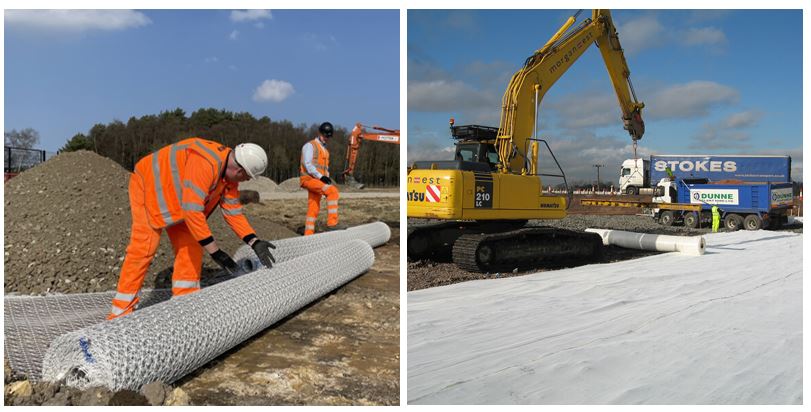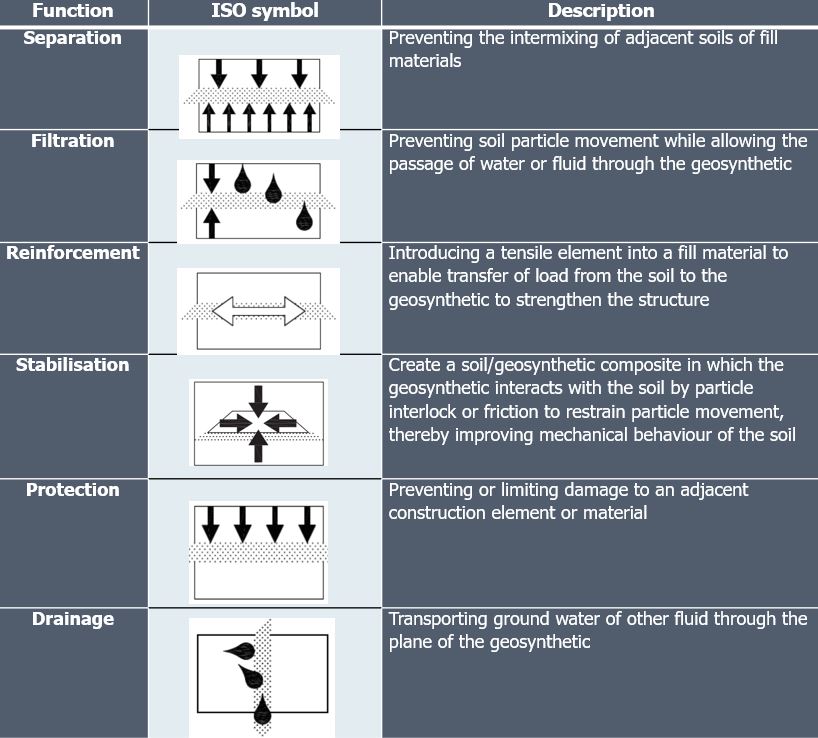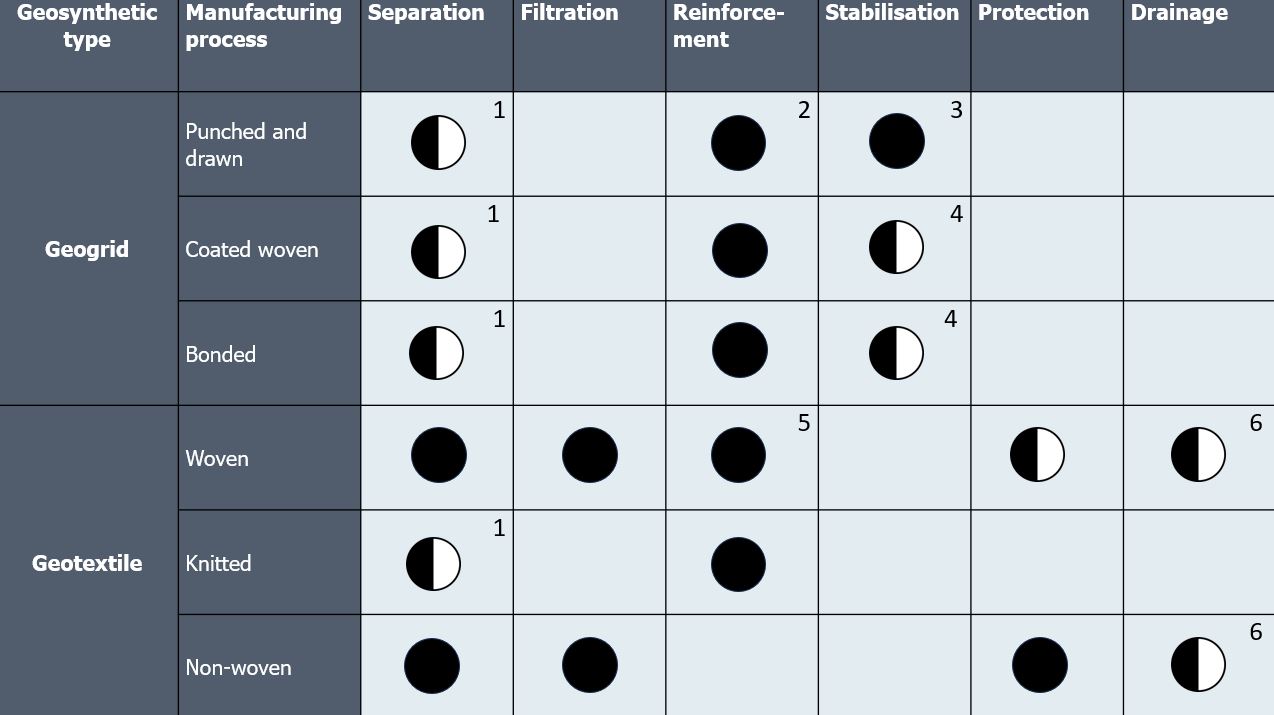Geogrids vs Geotextiles: What're the Differences?
by Jonathan Cook, on July 27, 2023
The differences between geogrids and geotextiles will be clear to those who work in geotechnical engineering and are familiar with these materials. But for anyone who is new to the subject, the nature and functions of these two types of materials may be confusing. Building on our introduction to geosynthetics, this guide compares geogrids vs geotextiles and explains the key differences for non-specialists.
There’s a lot of ground to cover here. If you want to learn about a specific area, use the links below to navigate to the relevant section:
- What are geotextiles?
- What are geogrids?
- How do I decide when to use a geotextile or a geogrid?
- The functions of geotextiles and geogrids
- Geocomposites
- What are the applications of geotextiles and geogrids?
- Geogrid vs geotextile: selecting the right product
- Next steps
.png)
Installation of geogrid (left) and installation of geotextile (right)
What are geotextiles?
Geotextiles are permeable synthetic fabrics, usually supplied in a wide roll, intended for use in contact with soil and rock. They are manufactured by weaving, knitting or by non-woven processes that mechanically, thermally, or chemically bond randomly oriented fibres. The method of manufacture, polymer type and product weight influence their performance characteristics and therefore their suitability for various intended functions.
Tensar uses a knitting process for its Basetex range of high-strength reinforcement geotextiles. The first recoded use was in 1956, meaning they have been around for almost 70 years. Their functions are well understood and there are national, international and industry standards and guidelines in place covering performance characteristics for common applications.
Geotextiles are a major category in the group of products collectively referred to as geosynthetics (a broad family of products used to solve specific geotechnical problems). These products are all manufactured from synthetic materials and are intended for use in direct contact with soil or rock. There are several categories performing one or more of the functions described in Table 1 below, the largest categories being geotextiles and geogrids.
What are geogrids?
Geogrids are planar synthetic structures consisting of a network of connected tensile elements. Importantly the open grid structure enables soil or aggregate to penetrate (or partially penetrate) the open apertures to interact with the structure. They are manufactured by punching and drawing an extruded sheet of polymer, by weaving and coating continuous fibres, or by bonding tensile elements. They are supplied in a roll form, with widths ranging from 1.0m to over 4.0m.
Invented in 1978 by Dr Brian Mercer through what is known as the Netlon proccess , they have been in use for over 40 years. The method of manufacture, polymer type, and geometry of the structure influence their characteristics and from that the functions and applications for which they are most suited. The functions, characteristics, and durability are well understood. There are national and international standards and guidance in place covering some of the key applications.
How do I decide when to use a geotextile or a geogrid?
The important considerations when selecting a geotextile or geogrid, or equally important, which geotextile or geogrid, are the required function and the intended application. By function we mean the considered role or purpose of the material. What are we asking it to do? By application we mean where and in what circumstances we are using the material and for what overall benefit. We will look at both function and application in more detail below.
The functions of geotextiles and geogrids
Geosynthetics like geotextiles and geogrids can perform a range of functions, from separation to stabilisation. The definitions of these functions are outlined below.
Table 1 – Definitions of geosynthetics functions
.png)
The table below explains the functions of geotextiles and geogrids (as defined by EN ISO 10318:2015+A1:2018). Black circle indicates primary function fulfilled. Half circle indicates secondary or partially fulfilled function.
Table 2 - The functions of geogrids and geotextile
.png)
Notes:
- Geogrids and knitted geotextiles can separate granular material from soil, for example in a road subbase/subgrade. However, they are not suitable in isolation for separating finer soil materials where water is present.
- High strength uniaxial punched and drawn geogrids are designed to provide a reinforcement function.
- Multi-axial punched and drawn geogrids (such as Tensar InterAx) are designed specifically to provide the stabilisation function.
- The stabilisation function requires confinement of aggregate particles via interlock. Adequate junction strength and stiffness is required to effectively confine the particles. Some woven or bonded geogrids may not provide confinement by interlock
- Woven geotextiles range from low strength lightweight, to very high strength products. The high strength option can be effective for reinforcement.
- Some specialist geotextiles are claimed to provide an in-plane drainage function.
Geocomposites
By bonding two or more geosynthetic materials together to form a single geocomposite, it is possible to combine multiple functions in one product. For example, a multi-axial geogrid bonded to a non-woven geotextile can provide stabilisation, separation, and filtration to a road foundation. There are many geocomposite products available to solve a variety of geotechnical problems.
What are the applications of geotextiles and geogrids?
Now that we are familiar with the functions of geotextiles and geogrids we can look at where these can be applied, to solve geotechnical problems
Table 3 - Examples of applications for geotexitles and geogrids.
| Application | Description |
| Road foundations, unpaved roads and working platforms | Stabilisation geogrids are used to mechanically stabilise subbase or capping layer material to increase bearing capacity and enable reductions in fill thickness |
| Geotextiles provide a separation function to prevent contamination of granular material over soft clay subgrade soils | |
| Higher strength geogrids and geotextiles provide a reinforcement function below the granular material to increase strength | |
| Road pavements | Stabilisation geogrids within the granular layers of a pavement reduce deformation and increase pavement life |
| Rail trackbed | Stabilisation geogrids below the sub-ballast increase foundation stiffness. |
| High strength geogrids and geotextiles are used to increase foundation strength and provide protection against catastrophic collapse over voids | |
| Stabilisation geogrids within the ballast reduce ballast migration increasing the period between maintenance and reduce ballast degradation | |
| Specialist geotextiles (and geocomposites) placed below the trackbed reduce fines migration and improve lateral drainage | |
| Embankment foundations | High strength geogrids and geotextiles are used to reinforce embankment foundations to increase stability |
| Earth retaining structures | High strength geogrids and geotextiles are used to construct reinforced soil walls and slopes |
| Geotextiles are used behind the face of retaining walls to provide separation and filtration to protect drainage aggregates | |
| Side drains | Geotextile lining of drainage trenches separate the granular drainage material and prevent migration of fines into the drain from the surrounding soil |
| Revetment works | Geotextiles are used to separate rock revetment layers and to prevent loss of fine material from the revetment substrate. |
| Pipelines | Geotextile provide protection to coated pipe materials |
| Geogrids are used below pipelines to reduce differential settlement in weak soils | |
| Lagoon capping | Lagoons can be capped using a combination of geogrids, geotextiles and other geosynthetics to support and separate the capping material |
Geogrid vs geotextile: selecting the right product
Geotextiles and geogrids offer proven solutions to a wide range of geotechnical problems. While there is some overlap in the applications for geotextiles and geogrids, they are very often performing very different functions. It is important to identify the required function and then to look at the essential performance characteristics needed to deliver that function in your specific project. Not all products perform the same: there are wide differences in cost, performance, durability and constructability.
Many suppliers of geosynthetics are able to provide specialist advice and some, such as Tensar, offer full design support and supply solutions. It is important to get advice on the suitability and performance of products from the manufacturers: cross check using available literature, case studies and references; ask to see product certification where appropriate, and for critical applications check the research literature for verification.
Next steps
This guide has explored the key differences between geotextiles and geogrids in terms of function and application. If you require geosynthetics or design engineering support for any of the projects discussed here, get in touch with our specialists today.
Interested to learn more? You may find these other articles useful:



.jpg?width=400&height=400&ext=.jpg)